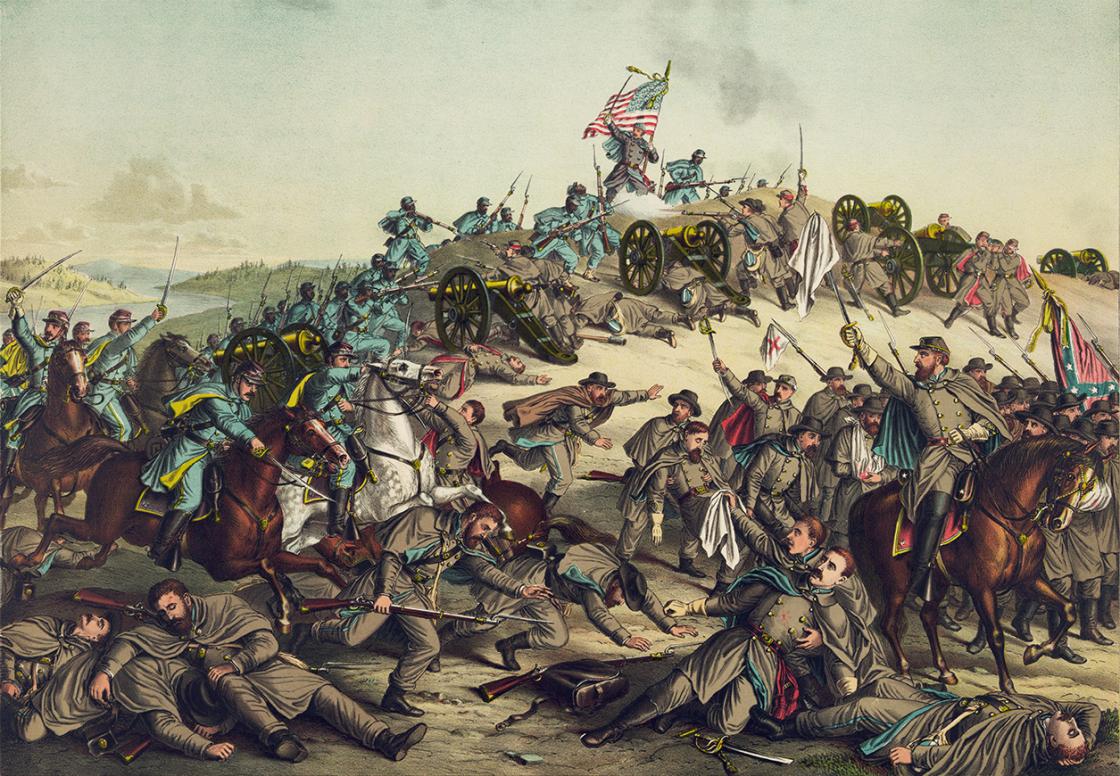The Battle of Nashville occurred on December 15-16, 1864, south of Nashville, Tennessee. The battle, between approximately 55,000 Union troops led by Major General George Henry Thomas and 30,000 Confederate troops led by Lieutenant General John Bell Hood, was considered a major Union victory in the Western Theater (the area west of the Appalachian Mountains) and one of the last major battles during the Civil War. It was also significant because African American Union troops played a crucial role in the Union victory.
African American Union soldiers served in the United States Colored Troops (USCT) regiments. The USCT consisted of eight regiments—the 12th, 13th, 14th, 16th, 17th, 18th, 44th, and 100th—all units of the U.S. Colored Infantry led by white officers. An estimated 13,000 USCT soldiers participated, the largest number of black soldiers on any battlefield until that point in the Civil War.
On December 15, 1864, the 13th USCT and the 2nd Colored Brigade (three regiments of black troops) were ordered to move in position for an assault on a Confederate battery position along the Nashville and Chattanooga Railroad near Nolensville Pike. The Confederates, who expected a Union attack, positioned their artillery to open fire on the USCT brigade. Confederate troops also opened fire on the 13th USCT, but they were guarded by earthworks. The 13th USCT used the earthworks as shelter as they exchange gunfire with Confederate forces. The 20th Indiana Battery arrived to give support to the 13th USCT, and with those reinforcements, they forced the Confederates to pull their cannons back.
The next day, Union Colonel Charles R. Thompson received orders to take his 2nd Colored Brigade to join General Thomas J. Woods’ 4th Corps. The 13th USCT along with the 12th and 100th USCT arrived at Peach Orchard Hill, where the Confederates immediately opened fire at them, but none of the USCT took any losses. General Wood told Thompson that he would attack the Confederate position at Overton Hill and requested three USCT regiments to support his left flank. Around 3:00 p.m., the Union troops began their attack. Thompson placed the 100th and 12th USCT in front and use the 13th as support. The 12th encountered a dense thicket which slowed their advance. Meanwhile the 100th USCT came upon several fallen trees that slowed their advance as well. Both regiments faced heavy fire from the Confederate troops occupying Overton Hill.
Colonel Thompson ordered the 12th USCT to take shelter to regroup. The 100th USCT and 4th Corps attempted to advance but were pushed back by the Confederates. The 13th USCT, however, pushed past the 2nd Brigade and continued to advance up the hill while subject to withering fire from Confederate troops. With no support from the white Union troops or other black regiments, who fell back from their positions, the 13th USCT continued to storm the Confederate earthworks. The regiment took heavy casualties but failed to take Overton Hill. Despite that failure, Confederate troops were forced to withdraw.
The Union Army went on to win the Battle of Nashville and end the Army of Tennessee (Confederates) as a fighting force in Tennessee. The battle, however, cost the 13th USCT dearly. The 900-soldier regiment lost four white officers and fifty-five enlisted men, who were killed in action; four white officers and one hundred sixty-five enlisted men were wounded. Their bravery in the battle was acknowledged by their white counterparts and officers alike. General George H. Thomas, a Virginian by birth who had previously harbored doubts about the black soldiers under his command, rode across the battlefield seeing the bodies of black Union soldiers and white Confederate soldiers lying together, said to his officers, “Gentlemen, the question is settled, negro soldiers will fight.”


